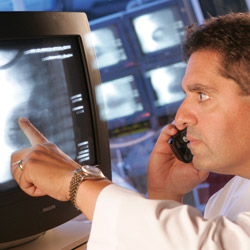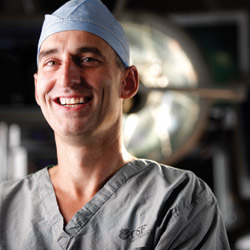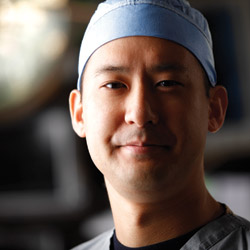Leaving a Mark on the National Healthcare Landscape

As we enter the second month of 2011, those New Year’s resolutions we made are either holding or fading fast (depending on your dedication!). For many, those resolutions involved something to do with their health.
Being the “picture of health” these days can be filled with complications we didn’t know existed not that many years ago. The good news is that new technology and educational opportunities help our doctors blaze new paths for research and treatment. Above all, it comes with new perspectives that will benefit all patients.
As it has been for more than 130 years, OSF Saint Francis Medical Center is on the cutting edge of new technology and techniques, with some of the most advanced physicians in the region. With a medical center that rivals those found in Chicago and other metropolitan areas, Saint Francis is taking a seat at the table with much larger teaching facilities and making a name for itself, not only locally, but statewide and nationally as well. As we focus on healthcare, we wanted to highlight some of the exciting advances taking place inside the doors of Saint Francis. Dr. Daniel Fassett, Neurosurgeon
Dr. Daniel Fassett, Neurosurgeon
When we hear the word “neurosurgeon,” many of us are instantly impressed. Combine that with a subspecialty in spinal deformities, tumors and orthopedics, and it’s even more impressive. Dr. Daniel Fassett of the Illinois Neurological Institute (INI) actually began his career as a chemical engineer, and in the transition to the medical field, found that spinal surgeries were his passion because he already understood the engineering behind them.
Dr. Fassett deals with many problems within his specialty, including injuries, tumors and degenerative problems of the spine. A patient could have a compression of his or her spinal cord that needs surgery to fix. Tumors of the spine are not uncommon, but are usually the result of other cancer spreading to the spinal area. This requires a collaborative effort, with Dr. Fassett working in conjunction with other physicians, including oncologists, physiatrists and pain interventionists. This multi-disciplinary approach ensures the patient is getting the most accurate diagnosis and treatment possible.
In addition to a team of specialists, Dr. Fassett is able to utilize some of the most sophisticated equipment in the world, such as the Trilogy™ Stereotactic System. Trilogy delivers focused radiation, so patients who qualify only need one radiation treatment of a few minutes to get the same results that could take weeks or months using other methods.
Although surgery should always be a patient’s last resort, Dr. Fassett and his team provide some of the most advanced in the country. Just ask Peoria resident Parimala Raman. Her complex and painful case of scoliosis was evaluated by specialists at the Mayo Clinic and Barnes Hospital in St. Louis. This degenerative disorder was complicated by her use of chronic steroids for another condition, which had led to osteoporosis. The specialists told her that the complicated surgery she would need was too risky. She and her family decided they would ask for one more opinion before giving up.
Dr. Fassett was able to utilize cobalt chromium rods (introduced in the last 18 months) to help straighten Raman’s spine, and after a complex surgery and extensive recovery, she is walking straight. “Since the cobalt rods were introduced, I’ve used probably as many as anyone in the country on complex spinal surgeries,” said Dr. Fassett. “It is amazing how this technology is able to help those who couldn’t be helped before."
Dr. Fassett and many other physicians at INI serve as faculty members for the University of Illinois College of Medicine at Peoria. This hands-on classroom involvement means that he and his colleagues are exposed to continuing education and research with some of the best physicians and hospitals in the country.
“There is really no need to travel any further than Peoria for the best care,” said Dr. Fassett. “With advanced technology, physicians and continuing research, Saint Francis has become a nationally renowned hospital.”  Dr. Andrew Tsung, Neurosurgeon
Dr. Andrew Tsung, Neurosurgeon
Another highly qualified neurosurgeon at INI is Dr. Andrew Tsung, director of the Brain Tumor Center. After completing his residency at the University of Illinois, Dr. Tsung completed a fellowship in neurological oncology at MD Anderson Cancer Center, where he did specialized training in the surgical management of brain tumors.
Dr. Tsung has always been interested in the field of neurosurgery due to its complexity and daily challenges. Currently, he and his team are researching ways to treat brain tumors using methods that isolate tumor cells. “Patients are diverse, even if they have the same type of cancer, and thus it takes expertise and a team approach to decide on the correct treatment,” says Tsung.
Dr. Tsung’s work encompasses all aspects of brain tumors, including radiation oncology, medical oncology, neurosurgery and neurology. He and his colleagues also provide radiation treatment with the use of the Gamma Knife—a form of stereotactic radiotherapy, some of the newest, most cutting-edge technology. The team is very involved in clinical trials involving malignant brain tumors. This is all research that comes out of one of the most well-funded brain tumor research laboratories in the country. It is here that they research the interaction of stem cells with cancer to determine how to slow down malignant brain tumor growth, contributing lifesaving information to the cancer research community every day.
“The Illinois Neurological Institute and OSF Saint Francis provide some of the most advanced neurosurgical care, not just in central Illinois, but in the country,” explains Dr. Tsung. “It parallels institutions such as the Mayo Clinic, Cleveland Clinic and others. I believe it is due to our efficiency, personalized approach, research and highly experienced, fellowship-trained neurosurgeons in every subspecialty that we have established ourselves as a superior research institution.”
Top-Notch Cardiac Care, Fast!
A patient having cardiac arrest needs the best medical care available—fast. When seconds are everything and mistakes can be fatal, a streamlined solution is imperative. The Heart 777 program, created by OSF Saint Francis Heart Hospital and HeartCare Midwest, is designed to shorten response time for the treatment of heart attacks, especially for those patients who live outside of the immediate Peoria area.
Currently, 14 hospitals partner with the Saint Francis team to provide this lifesaving care. How is it working? The program has exceeded the nationally recognized door-to-balloon standards for the past five years. Coronary arteries are opened more quickly and heart muscle is saved, thanks to the efficiency of this initiative.
One of the newer processes Saint Francis is on the forefront of is “induced hypothermia,” a process in which the body is safely cooled down to just above 90 degrees. The purpose of such a treatment is to decrease brain damage in heart attack patients by decreasing the oxygen demand and preventing chemical imbalances in the brain. The patient is kept cool for 24 hours, during which a highly trained intensive care team keeps close watch monitoring them.
For more than 130 years, OSF Saint Francis Medical Center has been leading the way in cutting-edge healthcare. Even with all of the technological successes, the physicians, nurses and staff know that the patient is the top priority. It is this patient-centered focus that continues to earn the medical center local and national recognition. iBi

